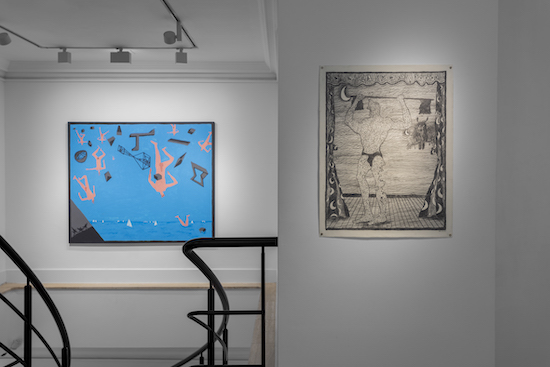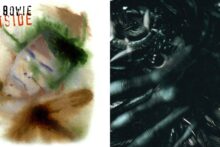All photos by Deniz Güzel, courtesy Gazelli Art House
”The world’s in peril (and it’s not possible to) avoid being in politics, whether one likes it or not”
The year is 1962 and this is the Portsmouth-born artist Derek Boshier talking to the soon to be notorious film director Ken Russell. Boshier was one of four young artists then profiled in Russell’s pioneering BBC production Pop Goes the Easel, the others being Pauline Boty, Peter Phillips, and the pre-Sgt. Pepper Peter Blake. All were already viewed at the time as exemplars of British Pop Art, a new wave following on from the innovations of Richard Hamilton and Eduardo Paolozzi in the 1950s.
Boshier’s righteous agitation back in ’62 was about The Bomb. Of course the threat of nuclear war remains a live issue but, as per contemporary fears on display at the COP26 conference, our planet is now in even deeper trouble. And sixty years on from that conversation Boshier, now aged eighty-four, shows no sign on this current showing that he’s lost any of his political angst.
There are two sets of contrasting works here. Downstairs the mood is lighter and features a sequence of large canvases that reference a recent TV phenomenon in South Korea called The King of Mask Singer. The idea is a variant on talent shows like Pop Idol or X-Factor. The singers compete whilst wearing fantastically designed masks; concealment in such a manner anonymises the contestant thus blinding the judges to any inherent bias – sexism, ageism, racism, etc. – they may, consciously or unconsciously, possess. The highlight of the show is when the reveal happens. The build-up to the unmasking is deliberately dramatised in a manner that recalls the shenanigans of Mexican wrestlers or, closer to home, the mystery of Kendo Nagasaki, subjects both Boshier and Blake have tackled decades before. Pop artists love such contrived suspense and delight in speculating on what exactly is being hidden and what might that tell us about ourselves.
It’s not a surprise that Boshier would find the Korean show fascinating; he’s long been enamoured by popular culture. He takes great joy in examining the surface texture of what’s new and draws, literally and figuratively, his own coolly ironic Kracauerian deductions. A recurrent signifier in each canvas is a giant ‘K’ which references Korea itself, Korean pop, and Kellogg’s breakfast cereal. This is a trope that goes right back to Boshier’s earliest Pop paintings, specifically Special K (1961). Like all great pop artists he understands Lesson One: know your product, be it a Campbell’s soup can or a F-111 aircraft.
Boshier’s palette here is deliberately restricted – reds and blacks predominate. The grotesquerie of the masks is highlighted in the cartoonish, Keith Haring-like monsters found in K Pop: King of Mask Singers (2020). The figures appear both frightening and ludicrous, an ambiguity Boshier clearly savours. K POP – The King (2021) and K POP-POP (2020) typify his use of a crude, shaky thick black line for his comic book figures with their strange hand gestures and manic grins. The utter weirdness of the TV show is caught by these paintings and you’re reminded of other destabilising images of masked craziness, such as those seen in various Kubrick movies. You think too of other painters revelling in the grotesque, as with those disturbingly feral creatures found in paintings by the deranged Austrian, Otto Muehl, or the marginally more refined, albeit no less angry, images of KKK klowns in Philip Guston’s work.
A unicorn figure got up in Bowie garb, a design à la Kansai Yamamoto, features in K POP-King Horse (2021). Boshier was a mate of Bowie’s and famously had his ideas all over the cover and insert for Lodger (1979). He also did the cover for Let’s Dance (1983). The broken, splayed body of Bowie on Lodger, the man who really has fallen to earth, references Icarus – another long term hobbyhorse of Boshier’s and the subject of the second series of paintings here, a more sombre affair to be found in the upper gallery.
These are about over-reach. After a week of seeing lines of diesel Mercedes parked in Glasgow to ferry the great and the good around a conference on environmental collapse, a week of ferrying helicopters and private jets wasping around the skies, Boshier’s conclusions here seem spot on. We’re doomed, as Private Fraser on Dad’s Army used to say. Here are the falling men. We’re all Major Tom now. We are the fallen.
Taking a cue from Auden’s Musée des Beaux Arts (1938) with its nod to Brueghel, Boshier refuses to turn away or ignore the splash of disaster like some indifferent ploughman. Life is not going to go on like it did back in Breughel’s day. And so we get Icarus and Political Republican Friends (2020), some got up in white KKK hoods in the Guston manner, some fitted out with a pig’s head recalling that barking story about David Cameron. They’re all black-suited and booted and all of them plunge through a roughly rendered blue sky, down, down, down, into a near identically coloured sea below. Sketchy white yachts sail by and ignore them, contemporary equivalents of Brueghel’s ploughman. Planet Earth is blue and there’s nothing they, or we, can do to avoid our own destruction.
Icarus and Macho Friends (2021) gives us more wrestlers, gun-fighters, cowboys and gangsters, all resigned to the same trajectory: southbound to oblivion. Boshier has long been a critic of male toxicity and warmongering, a veteran of the CND Aldermaston Marches of the late 1950s, and he rams his message home with Icarus Remembers (Beware of the Military/Industrial Complex) (2021) with its high-tech weaponry, its Chinooks and Black Hawks, its Stealth bombers and Lockheed Raptors, all diving into the drink.
Boshier, like other British painters obsessed with men and war and weaponry – the late Malcolm Morley and Richard Patterson come to mind – relocated to the US and is currently based in Los Angeles. Like them his work melds the realistic and the abstract, although in Boshier’s case the results are a deliberately looser affair. His imagery is nowhere near as crystalline and is not particularly concerned in achieving photographic clarity.
Boshier’s life’s work, Janus-like, alternately looks back to provocateurs of the past and predicts future shockers. Like Picabia before him, he thrills in delivering garish provocations with darkly mocking laughter, and takes similar delight in creating cheap but potent effects with the minimum of artisanal fuss. And, staring forwards, his scabrous collages predict the feral delights of Mark Flood’s harum-scarum cut-ups. One wonders if Houston-born Flood saw Boshier’s Texan works during the latter’s extended 70s stay in the city…
Boshier is not as well known in the UK as Peter Blake; he’s not as academically admired as Richard Hamilton; he’s not seen as a tragic figure like Pauline Boty. But given his influence, his interactions and collaborations with several key figures in British popular culture – Bowie and The Clash, Roxy Music and Barney Bubbles, Ken Russell and David Hockney – surely it is high time he had his due and is given a proper retrospective in this country.
Derek Boshier: Icarus and K Pop is on at Gazelli Art House until 13 November



